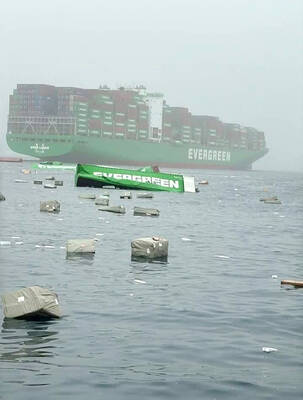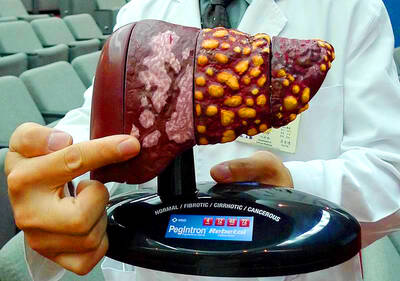Three years of observation of atmospheric lightning phenomena — a temporary colorful lightning appearing high in the sky during thunderstorms — recently allowed a research team at National Cheng Kung University’s Department of Physics the be first in the world to present a detailed global map of the events.
In a press release yesterday, the department’s Imager of Sprite and Upper Atmosphere Lightning (ISUAL) research team said that images taken over the past three years by the satellite FORMOSAT-2 showed that 80 percent of the luminous phenomena the team recorded were “elves,” or red bursts of light in the shape of donuts in the sky caused by lightning.
The other 20 percent of the luminous events recorded by the team were made up of “sprites” — a bell-shaped flash of light appearing about 50km to 90km in the air during thunderstorms — and two other types of lightning: “halos” and “gigantic jets,” the release said.
Hsu Ruey-rong (許瑞榮), a professor of physics from the department who was responsible for the research, said that images taken by the satellite had helped the team analyze the locations where “sprites” and “elves” were more likely to be found.
The team found that “elves” usually appeared above the sea, such as the Caribbean Sea, the South China Sea, east Indian Ocean, and the central, west and southwestern Pacific Ocean, while “sprites” tended to show up above land such as central Africa, Hsu said.
Su Han-tzong (蘇漢宗), another professor of physics at the department, said the research team also found that warm seawater — above 26°C — might contribute to “elves.”
“A warm ocean surface can provide the heat source needed to drive intense oceanic lightning with very high peak currents, which usually generate elves in the ionosphere,” Alfred Chen (陳炳志), a professor of astronomy at the school, said in an interview with the New Scientist.
“Elves could have an important global effect on the lower ionosphere and the total electron content,” said Chen.
“Elf hotspots may increase the electron density of the ionosphere by 5 percent or more, which could interfere with ground and space communication as well as navigation systems,” he said.
The university organized the nation’s first “sprite” research team in 1998 and has cooperated with National Central University, National Chiao Tung University, the University of California, Berkeley, and Japan’s Tohoku University, in its research into atmospheric lightning phenomena over the past decade.
The research results of the ISUAL team — which consists of Hsu, Su, Chen and other researchers — was recently publicized in the Journal of Geophysical Research.
ADDITIONAL REPORTING BY CNA

The Executive Yuan yesterday approved a southwestern extension of the Sanying MRT Line from New Taipei to Bade District (八德) in Taoyuan, with a goal of starting construction by late 2026. The 4.03-kilometer extension, featuring three new stations, will run from the current terminus at Yingtao Fude Station (LB12) in New Taipei City to Dannan Station (LB14), where it will connect with Taoyuan’s Green Line, New Taipei City Metro Corp said in a statement. This extension will follow the completion of core Sanying Line, a 14.29-kilometer medium-capacity system linking Tucheng (土城), Sansia (三峽)

CARGO LOSS: About 50 containers at the stern of the ‘Ever Lunar’ cargo ship went overboard, prompting the temporary closure of the port and disrupting operations Evergreen Marine Corp, Taiwan’s largest container shipper, yesterday said that all crew members aboard the Ever Lunar (長月) were safe after dozens of containers fell overboard off the coast of Peru the previous day. The incident occurred at 9:40am on Friday as the Ever Lunar was anchored and waiting to enter the Port of Callao when it suddenly experienced severe rolling, Evergreen said in a statement. The rolling, which caused the containers to fall, might have been caused by factors including a tsunami triggered by an earthquake in Russia, poor winter sea conditions in South America or a sudden influx of waves,

The Ministry of Culture yesterday officially launched the “We TAIWAN” cultural program on Osaka’s Nakanoshima sandbank, with the program’s mascot receiving overwhelming popularity. The cultural program, which runs from Aug. 2 to 20, was designed to partner with and capitalize on the 2025 World Expo that is being held in Osaka, Japan, from April 13 to Oct. 13, the ministry said. On the first day of the cultural program, its mascot, a green creature named “a-We,” proved to be extremely popular, as its merch was immediately in high demand. Long lines formed yesterday for the opening

STAY VIGILANT: People should reduce the risk of chronic liver inflammation by avoiding excessive alcohol consumption, smoking and eating pickled foods, the physician said A doctor last week urged people to look for five key warning signs of acute liver failure after popular producer-turned-entertainer Shen Yu-lin (沈玉琳) was reportedly admitted to an intensive care unit for fulminant hepatitis. Fulminant hepatitis is the rapid and massive death of liver cells, impairing the organ’s detoxification, metabolic, protein synthesis and bile production functions, which if left untreated has a mortality rate as high as 80 percent, according to the Web site of Advancing Clinical Treatment of Liver Disease, an international organization focused on liver disease prevention and treatment. People with hepatitis B or C are at higher risk of